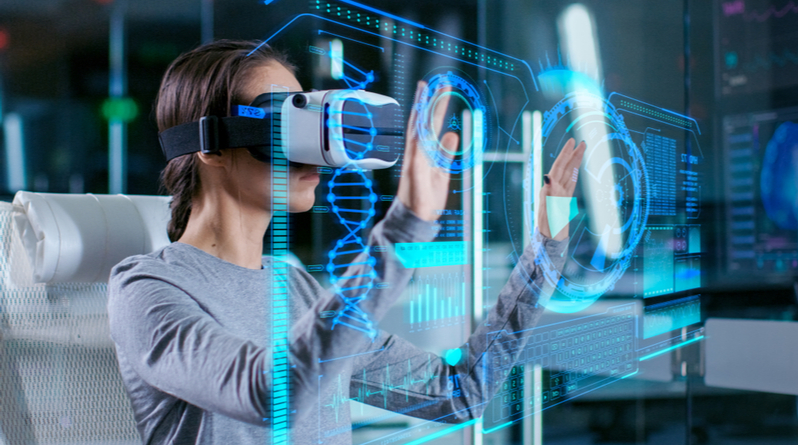What is Augmented and Virtual Reality?
Augmented reality (AR) is an enhanced version of the real physical world that is achieved through the use of digital visual elements, sound, or other sensory stimuli delivered via technology.
Augmented reality uses the existing real-world environment and puts virtual information on top of it to enhance the experience.
Virtual reality immerses you in a virtual world through the use of a headset with some type of screen displaying a virtual environment. These headsets also use a technology called head tracking, which allows you to look around the environment by physically moving your head. The display will follow whichever direction you move, giving you a 360-degree view of the virtual environment.
What 3rd level courses are available?
Universities and colleges in Ireland are offering courses in Augmented and Virtual Reality in the following subject areas:
- Higher Diploma in Science in Augmented and Virtual Reality Development – Gain the knowledge, skills and competencies to design, develop and evaluate immersive user experiences with virtual, augmented and mixed reality technologies.
- Virtual Motion: Augmented and Virtual Reality (HND) Level 6 Higher – This course focuses on augmented and virtual reality, motion graphics and interpreting and creating interactive experiences in real-time 3D environments, using industry-standard tools, theory and techniques.
- Visual media BA Hons (Game Design) – This course is designed to challenge students to develop and integrate their technical, creative and academic skills in a structured way.
- Software Design with Virtual and Augmented Reality – Develop the skill set to blend key technical, creative and user experience expertise such that graduates can apply same across industry domains in Virtual and Augmented Reality applications.
- BSc (Hons) in Augmented and Virtual Reality – Gain an understanding of how people can usefully navigate and interact within immersive environments leading to the creation of more “natural” methods of interacting and exploring immersive space.
Studying Augmented and Virtual Reality
There are many courses in Augmented and Virtual Reality that may take place over a few days, weeks or even 1 year to 4 years depending on the course and modules selected. There are also part-time courses and night courses available so you can be sure to fit in your studies no matter what your schedule is like.
Courses will cover theory work through lectures, assignments, tutorials and taught modules. Assessments will take place on a continuous basis with written examinations and practical assignments combined in order to achieve a qualification.
You could also consider work experience or a work shadow in the industry. Relevant work experience is a good way of demonstrating a genuine interest in computing and is regarded favorably by employers. Gain experience through course-related placements, opportunities to work shadow or a year in the industry.
Work Experience will not only give you the opportunity to obtain a deeper knowledge and understanding of the industry, it will also give you a chance to do some essential networking with other industry professionals and gain valuable contacts for the future.
Career options
After completing an Augmented and Virtual Reality course you will be able to get started in a career that uses specific knowledge of scientific and mathematical principles in order to create computer software and solve problems.
A software engineering qualification sets you up with technical IT skills that can be used in various IT and web-based careers from web design to augmented and virtual reality applications.
Within the field, you will typically work in a constantly evolving environment due to technological advances. You’ll create, maintain, audit and improve systems to meet particular needs, often as advised by a systems analyst or architect, testing both hard and software systems to diagnose and resolve system faults.
Depending on the organization you work for, you may have a more defined role and work within a group of IT specialists which can include systems analysts, systems designers and systems testers. Nevertheless, as software engineers often manage the support systems required to effectively run an organization, the role can also require you to communicate effectively and translate the needs of different teams into systems developments.
Software engineers are employed in a very broad range of sectors, from Specialist IT firms to the Manufacturing industry or Financial Services.
Working hours will depend on whether you are self-employed, employed by a company with set business hours or if you are contracted to various businesses or companies. Working hours are typically 9 am to 5 pm. However, longer hours are often necessary towards the end of projects as deadlines approach, as well as during the testing stage so that systems can be tested when they’re not being used. In some cases, software engineers may be required to be on call to deal with problems. This can involve evening and weekend work in a shift pattern.
Related jobs include:
- Content producer
- Software engineer
- AR and VR content writers
- Product management
- Quality assurance
- UI and UX design
- Applications developer
- Cyber security analyst
- Game developer
- Information systems manager
- IT consultant
- Multimedia programmer
- Web developer
- Web designer
- Software engineer
- Application analyst
- Database administrator
- Forensic computer analyst
- IT technical support officer
- Software tester
- Sound designer
- Systems analyst
- Data analyst
- Game designer
Further study
After completing a course in Augmented and Virtual Reality you may choose to pursue further study in a specialist field to increase your knowledge base and skill set. Postgraduate study can also be used as a means to change career focus or to gain professional qualifications required to practice in certain career areas such as computer security, forensic computing, data science, computer science, computer software, computer systems engineering, electronics, information systems, mathematics or physics.
FAQ
What is the difference between augmented and virtual reality?
Augmented reality (AR) adds digital elements to a live view often by using the camera on a smartphone. Examples of augmented reality experiences include Snapchat lenses and the game Pokemon Go.
Virtual reality (VR) implies a complete immersion experience that shuts out the physical world. Using VR devices such as HTC Vive, Oculus Rift or Google Cardboard, users can be transported into a number of real-world and imagined environments such as the middle of a squawking penguin colony or even the back of a dragon.
The distinctions between VR and AR come down to the devices they require and the experience itself: AR uses a real-world setting while VR is completely virtual. VR requires a headset device, but AR can be accessed with a smartphone or other smart device. AR enhances both the virtual and real-world while VR only enhances a fictional reality.
Where can I study Augmented and Virtual Reality?
Explore your options here
Did You Know?
- The First VR Headset came out in the 1960s. Coined as the “Telesphere Mask” by inventor Morton Heilig, this device features stereoscopic (3-D) TV, wide vision and true stereo sound.
- Virtual reality enthusiasts can’t point to a single person who is responsible for the creation of VR. Instead, many people contributed to the technology’s growth. There are at least five people who can lay significant claim to the title: Morton Heilig, Jaron Lanier, Douglas Engelbart, Ivan Sutherland, and Myron Krueger.
- VR isn’t all about Games and Entertainment. Virtual reality is being used in the healthcare field to treat depression, anxiety, autism, PTSD and even nicotine addiction with Mindcotine.
- Virtual Reality is expected to reach $34 billion by 2023 according to Markets and Markets and a combined total of $94 Billion including augmented reality by 2023.
- 48% of Shoppers are already using or willing to use AR to assess new products and services












Comments